Krill
Euphausiacea
The krill is perhaps the most important animal in the marine ecosystem!
Advertisement
Krill Scientific Classification
- Kingdom
- Animalia
- Phylum
- Arthropoda
- Class
- Malacostraca
- Order
- Euphausiacea
- Scientific Name
- Euphausiacea
Read our Complete Guide to Classification of Animals.
Krill Conservation Status
Krill Facts
- Prey
- Plankton
- Group Behavior
- Swarm
- Fun Fact
- The krill is perhaps the most important animal in the marine ecosystem!
- Estimated Population Size
- Trillions
- Biggest Threat
- Changing climate and habitat
- Most Distinctive Feature
- The bioluminescent body
- Gestation Period
- A few days
- Habitat
- Coastal and deep ocean regions
- Predators
- Whales, seals, birds, fish, and humans
- Diet
- Omnivore
- Favorite Food
- Both plants and animals, depending on the species
- Type
- Crustacean
- Common Name
- Krill
As one of the most abundant animals in the entire food chain, the krill fish is foundational to many of the world’s marine ecosystems.
It provides food for hundreds of different species of animals, especially in the otherwise harsh Arctic and Antarctic waters. The krill fish is also an interesting creature in its own right. These tiny animals emit light from their transparent bodies and hard shells. The name krill derives from a Norwegian word that means small fry of fish, but it is actually a type of crustacean.
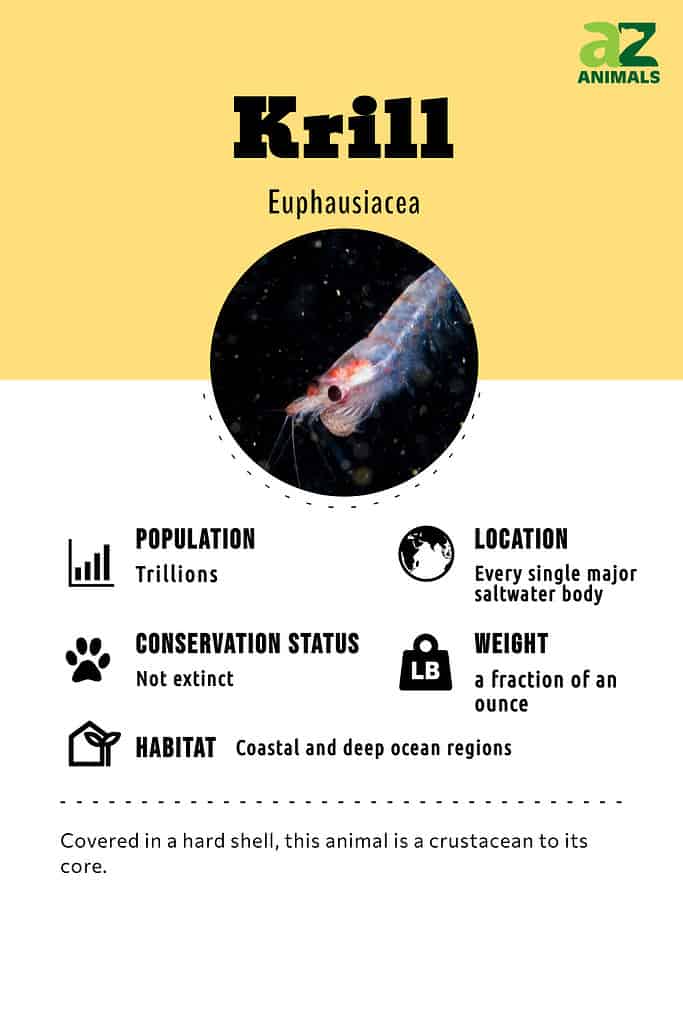
3 Incredible Krill Facts!
- The krill fish isn’t a social species in the same sense as many birds and mammals. Nevertheless, they travel together in massive groups called swarms for protection. These swarms regularly migrate between the deeper waters in the daytime and shallower waters in the nighttime. Some swarms are so large that they’re visible on satellite images.
- The krill move from place to place by floating along the ocean currents. When they encounter a predator, the krill can make a hasty escape by swimming rapidly backward at a pace of around 10 body lengths per second. This is a trick known as lobstering.
- The waste of the krill is a critical component of the planet’s carbon cycle.
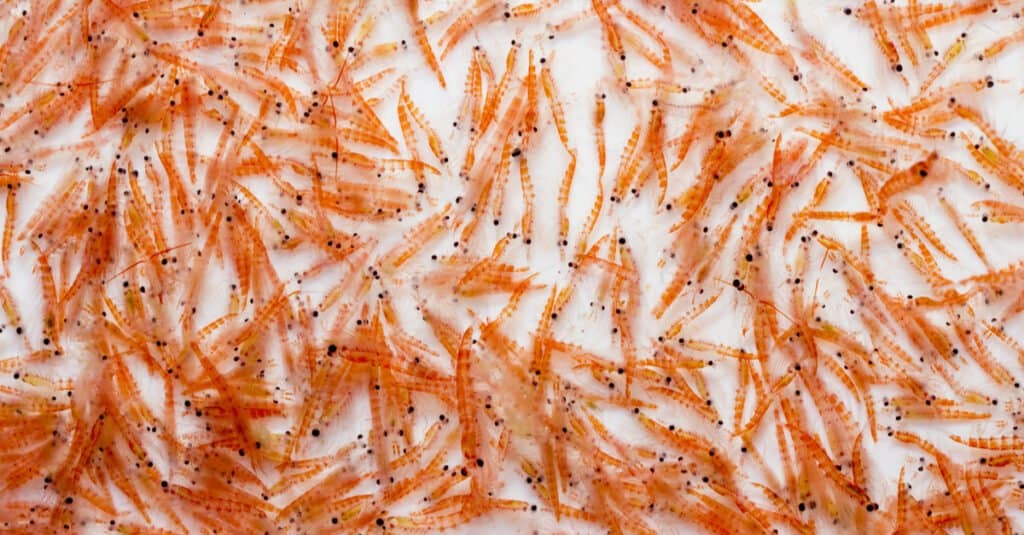
The krill is a large order composed of some 86 species divided into two broad families.
©I. Noyan Yilmaz/Shutterstock.com
Scientific Name
The scientific name of these animals is Euphausiacea. This comes from the Latin and Greek term euphausia, meaning light or illumination. The name was probably given because of their bioluminescent glow. They belong to the class of Malacostraca, which contains some 40,000 species of crustaceans. The defining feature of the Malacostraca and all crustaceans, in general, is the presence of a hard shell composed of a carbohydrate material called chitin.
Species
The krill is a large order composed of some 86 species divided into two broad families. The family of Euphausiidae contains almost every single known species of krill. The family of Bentheuphausia contains only a single species. Here is just a small sample:
- Antarctic Krill: Despite living in the inhospitable waters of the extreme south, this is perhaps the most abundant animal species on the planet.
- Ice Krill: Living right off the coast of Antarctica, the ice or crystal krill is the farthest south of any krill species.
- Northern Krill: This species is endemic to the northern parts of the Atlantic Ocean.
- Arctic Krill: Measuring no more than an inch in length, this species is an important prey item for shearwaters, marine mammals, and some plankton-eating fish.
- Deep Sea Krill: In the Bentheuphausiidae family, its only species is the Bentheuphausia amblyops, a krill living in deep waters below 3,300 ft. This species is considered the most primitive extant krill.
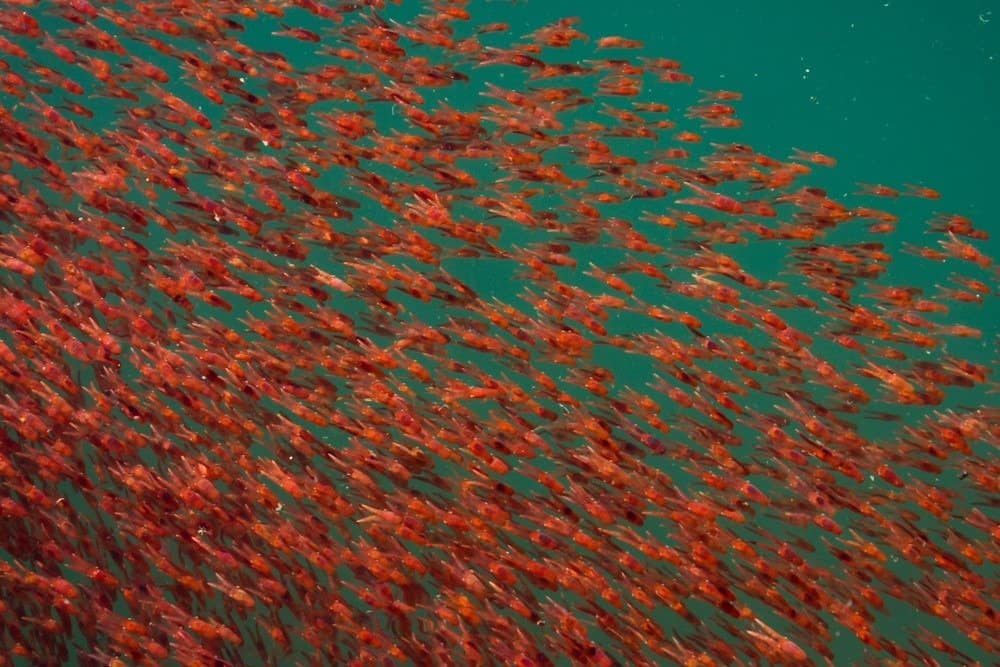
Lobster krill swarm in seawater. The krill fish isn’t a social species but they travel together in massive groups called swarms for protection.
©Apple Pho/Shutterstock.com
Appearance
Covered in a hard shell, this animal is a crustacean to its core. It has a long body divided into three sections (the cephalon, thorax, and abdomen) with a pair of antennae, 10 swimming legs, plus external gills to take in oxygen. It is also among the smaller species of crustacean, measuring no more than 2.4 inches long, or about the same size as a paper clip, and weighing a fraction of an ounce. They have transparent bodies that give off a rather bright glow. The light is a product of internal organs called photophores. It is not exactly known what purpose this light serves, but it might be related to camouflage or social signaling.

Antarctic krill Euphausia: Covered in a hard shell, this animal is a crustacean to its core.
©Krill666.jpg: Uwe Kils / Creative Commons – License
Krill vs. Shrimp
The krill is sometimes mistaken for a shrimp because of the similarities between their long, segmented bodies. But the main differences are that the shrimp has two segments, a colorful non-transparent body, and a slightly large size. The biggest shrimp can even grow up to a foot in length.
Distribution, Population, and Habitat
These crustaceans are versatile and adaptable animals that inhabit just about every single major saltwater body on the planet between the Arctic and Antarctica. This includes both coastal and deepwater regions. The total number of the worldwide krill population is truly staggering. It is estimated that the entire biomass of the Antarctic krill alone (meaning the total mass of every member of the species put together) is between 125 million and six billion tons, among the largest in the animal kingdom. It is the equivalent of trillions of individuals.
However, this impressive number hides some worrying trends. Some scientists have estimated that the population of this species may have fallen some 80% since the 1970s due to climate change, disease, and overfishing (though it is not yet threatened).
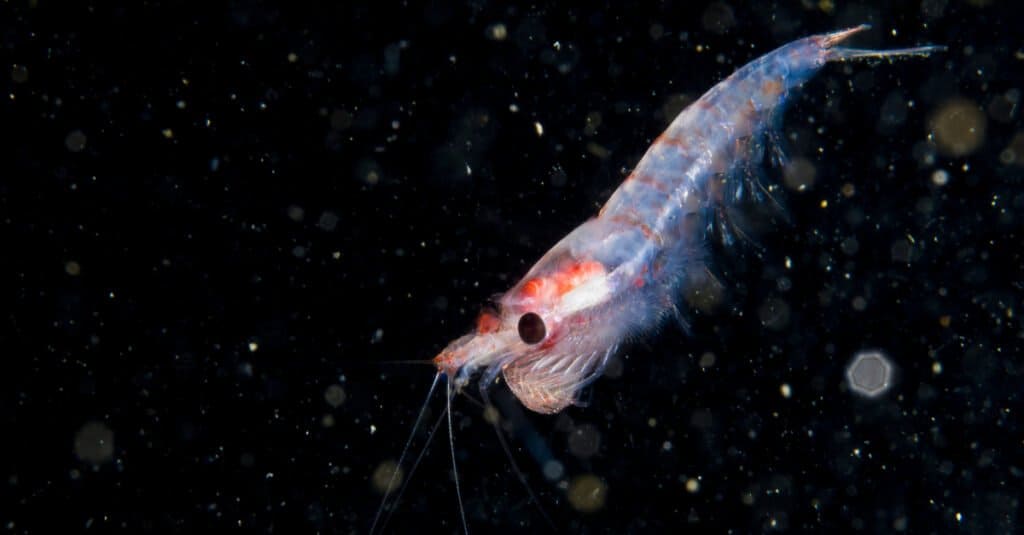
Scientists theorize that krill light up to sound an alarm when predators are near, but they have no definitive conclusion.
©RLS Photo/Shutterstock.com
Predators and Prey
These animals are an essential link in the marine food chain. It connects the microscopic marine organisms at the bottom of the chain to the much larger predators at the top. The vast majority of them are herbivorous or omnivorous, feeding on small algae or microscopic animals that happen to pass by. A few species are exclusively carnivorous and supplement their diet with fish larvae. The krill feed by filtering out edible material from their small appendages. They passively suck up the vast quantities of small food in the water.
Higher up the food chain, the krill is perhaps the most widely consumed animal in the entire marine ecosystem. It is an essential prey for seals, birds (especially penguins), whales, and all manner of fish. Therefore, any disruption in the abundance of these animals can have larger ramifications for the food chain. Threats include marine pollution, climate change, and alterations to the habitat or abundance of prey. The krill are caught frequently in some fishery locations, which may drive down numbers as well.
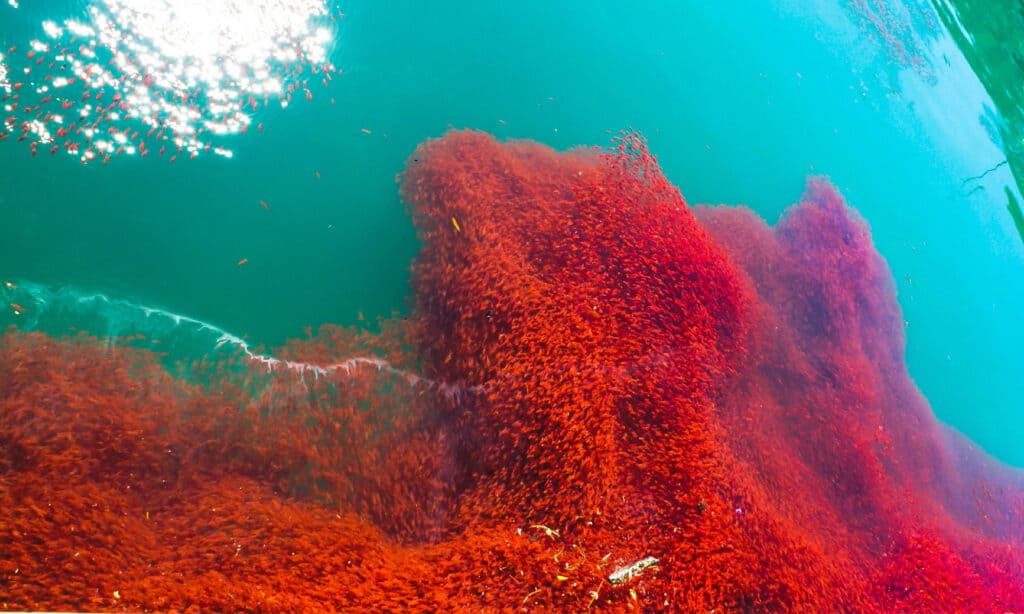
Worldwide, krill consumption is still a relatively niche phenomenon, at least compared to the closely related shrimp,
©Apple Pho/Shutterstock.com
Reproduction and Lifespan
These crustaceans have a distinct breeding season that varies based on location and climate. After the male deposits his sperm sack near the female’s genitals, she lays thousands of eggs throughout the entire breeding season, often spaced out into multiple broods. In total, these eggs weigh the equivalent of a third of her mass. Depending on the species, the female will either release the eggs directly into the water or carry them in a specialized sac for the duration of the gestation period.
After hatching from the eggs, the young will pass through several larval stages. In the early stages, the undeveloped krill lack the appropriate feeding apparatuses and survive almost exclusively on the egg yolk. In later stages, they develop a mouth and digestive system for consuming plankton. Each stage requires them to replace their entire exoskeleton through a series of molts. Life expectancy depends on where the species is located. Krill that occupy the warm tropical or subtropical waters live between six and eight months, whereas polar species live as long as six years if they can successfully evade predators.
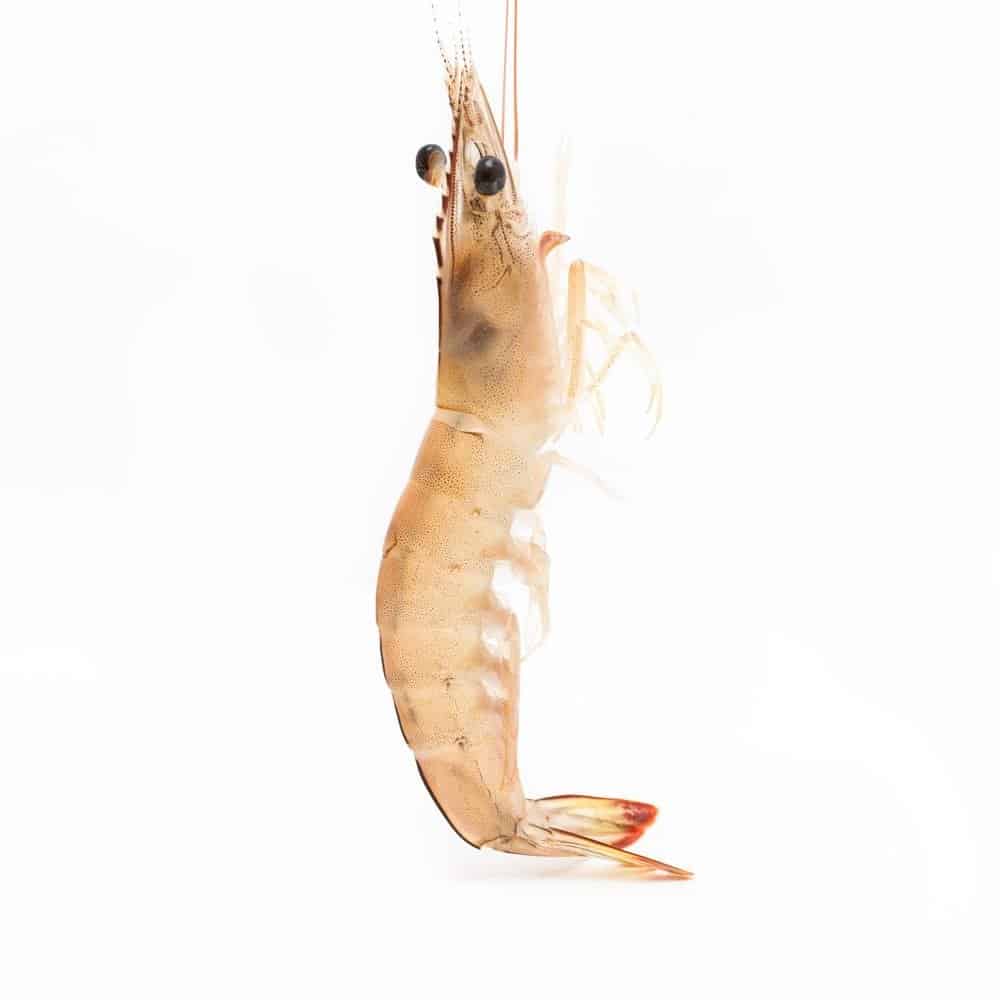
Krill have a distinct breeding season that varies based on location and climate.
©litchima/Shutterstock.com
Fishing and Cooking
Worldwide, krill consumption is still a relatively niche phenomenon, at least compared to the closely related shrimp, but it is an important source of seafood in Russia, Spain, Japan, and the Philippines. These countries each developed a large-scale fishery in the mid-20th century to catch vast amounts of these animals. The Antarctic krill fishery is preferred most of all due to the abundance of these species and the ease with which they’re caught. Other uses for krill include aquarium food, pet or livestock food, fishing bait, and nutritional supplements.
Fish Oil vs. Krill Oil
Krill oil is a very nutritious supplement that includes high levels of protein and omega-3 fatty acids. These fatty acids are associated with lower risks of cardiovascular disease. Not enough research has been conducted to tease out the difference between fish oil and krill oil, but the omega-3 fatty acid is largely the same in both of them.
Evolution and Origin
Krill has no fossil records, so little is known about their past. However, scientists have studied the DNA of modern krill with their closest relatives that have fossil remains. Using the molecular clock methods, scientists determined the last common ancestor of the Euphausiidae lived in the lower Cretaceous period, about 130 million years ago. From there, two lineages survived the extinctions, 65 million years ago, and the modern genera were established before the end of the Palaeogene era, 23 million years ago.
All of this to say, this crustacean has been around for a long time and has been a vital part of the ecology of the world’s oceans.
View all 77 animals that start with KKrill FAQs (Frequently Asked Questions)
What is krill?
The krill is a small, transparent, three-segmented crustacean that occupies most of the world’s seas and oceans.
What do krill eat?
The krill passively filters out plankton and fish larvae from the surrounding water.
Is krill a shrimp?
Krill and shrimp are quite distinct from each other. Although both belong to the class Malacostraca (along with lobsters and crabs), the shrimp is part of an entirely different order.
Can humans eat krill?
Yes, despite its small size, the krill is just as edible as shrimp, lobster, and crab.
Where do krill live?
The krill inhabits almost every major saltwater body on the planet, including the Southern Ocean near the Antarctic.
What Kingdom do Krill belong to?
Krill belong to the Kingdom Animalia.
What phylum do Krill belong to?
Krill belong to the phylum Arthropoda.
What class do Krill belong to?
Krill belong to the class Malacostraca.
What order do Krill belong to?
Krill belong to the order Euphausiacea.
What type of covering do Krill have?
Krill are covered in Hard Outer Shells.
What type of habitat do Krill live in?
Krill live in coastal and deep ocean regions.
What are some predators of Krill?
Predators of Krill include whales, seals, birds, fish, and humans.
What is the scientific name for the Krill?
The scientific name for the Krill is Euphausiacea.
What is the lifespan of a Krill?
Krill can live for up to six years.
What is a distinguishing feature of the Krill?
Krill have a bioluminescent body.
What is the biggest threat to the Krill?
The biggest threats to Krills are climate change and altered habitats.
How many Krill are left in the world?
There are trillions of Krill left in the world.
What is an interesting fact about Krill?
The Krill is perhaps the most important animal in the marine ecosystem!
How do Krills have babies?
Krills lay eggs.
What is the difference between a krill and a shrimp?
The greatest differences between krill and shrimp include their size, morphology, and body color. Krill are smaller than shrimp. The former has a body with three segments rather than the two that shrimp have, and have a mostly transparent exoskeleton with pink hues instead of the shrimp’s distinct pinkish brown color.
Thank you for reading! Have some feedback for us? Contact the AZ Animals editorial team.
Sources
- National Geograhic, Available here: https://www.nationalgeographic.com/animals/invertebrates/group/krill/
- Thought Co, Available here: https://www.thoughtco.com/krill-facts-4153991

















